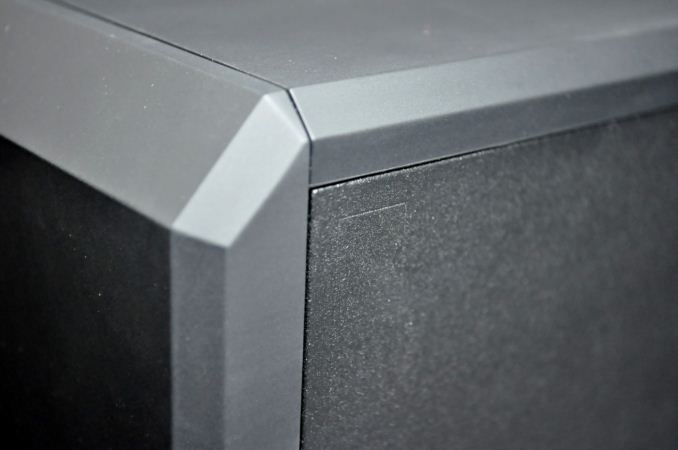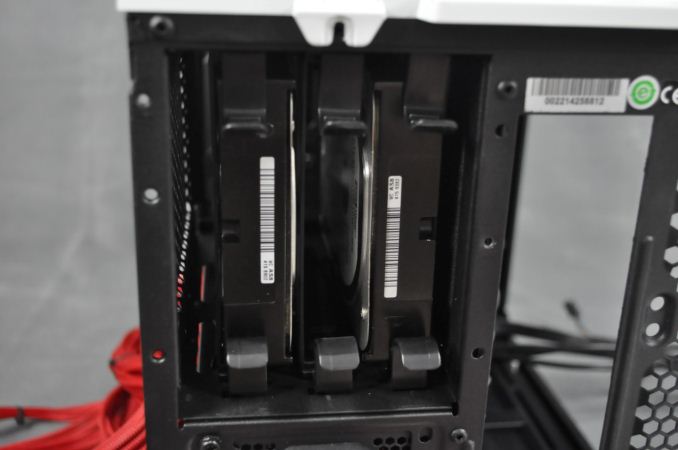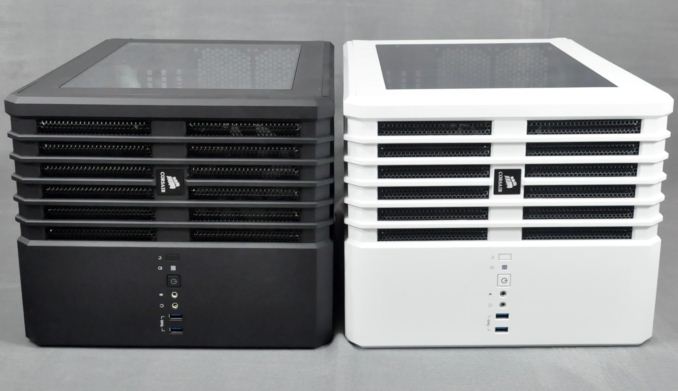Corsair Carbide Air 240 Case Review
by E. Fylladitakis on August 15, 2014 6:00 AM EST- Posted in
- Cases/Cooling/PSUs
- Corsair
- ATX
- Case
- Carbide
Corsair Carbide Air 240 Exterior
"And we shall call it…mini-540". This is what Corsair must have been thinking while designing their latest addition to the Carbide series, the Air 240. The new Micro-ATX case looks exactly like an undersized version of the Carbide Air 540 that we reviewed a little over a year ago. With a size of 315mm × 265mm × 400mm (H×W×D) and a total volume of 0.0334m3, the Carbide Air 240 is not a very compact Micro-ATX case, yet it takes less than half the volume of the Air 540 (61.55% less) and less volume than the Obsidian 350D (21.87% less). It also adds Micro-ATX compatibility over the Obsidian 250D for just 16.9% more volume.
Corsair currently offers the Carbide Air 240 in two colors, black and white, both of which are depicted in the following galleries. It is interesting to note that the metallic parts of the black version have been sprayed with a grainy, satin black paint, while a smooth matte black paint covers the plastic parts. The difference in the paint on the black isn't a major deal, but it is apparent when performing a close inspection. The white version on the other hand is immaculate, with the entire exterior having being sprayed with a satin white color.
Aesthetically, the Carbide Air 240 sports an interesting asymmetric design that hints at the internal dual-chamber configuration. The left part of the faceplate is vented, as is the left part of the top and bottom panels as well, creating exceptional cooling possibilities for the main system. We can see the I/O ports and buttons on the right middle side of the faceplate, with the company logo in alignment towards the left side of the case. The left side panel is almost entirely covered by a transparent acrylic window, revealing the entire main system to the spectator.
The top and bottom panels of the Carbide Air 240 are secured with two thumbscrews each. By removing these thumbscrews, both panels easily slide off. However, as the case actually sits on the bottom panel, it will have to be placed on its side or upside down before removing it. The removal of either panel reveals the frame for the installation of 120mm fans and/or liquid cooling radiators.
It is very interesting that Corsair went with a "rails" design, allowing the user to adjust the location of the fans/radiator by a few centimeters towards the front or the rear of the case. Each of the side panels is secured with two thumbscrews each as well, but these thumbscrews are partially threaded and do not come off the panel when removing it. The front panel can also be removed, but the user needs to first remove both side panels and undo the plastic clips that hold the front panel in place.
Even though the right side panel of the Carbide Air 240 will have to be removed before the user can wire any of the drives, both drive cages are accessible from the exterior of the case. The 2.5" drive cage is beneath the top panel, which has to be removed in order to gain access to it. The 3.5" drive cage is accessible from the rear of the case, by removing a perforated metallic cover held in place with a single thumbscrew. The plastic trays of the 3.5" cage can hold 2.5" drives as well. Strangely, even though the plastic trays have been inserted facing rightwards from the factory, they need to be installed facing leftwards in order to fit three full-size 3.5" mechanical disks.
It is also possible to use the Carbide Air 240 sideways and there are even slots on the metallic right side panel for the rubber feet that Corsair provides in the bundle. However, that will also rotate the faceplate and everything printed on it, including the I/O legend and the case badge, making the Carbide Air 240 look rather odd and off-place. The case badge is magnetic and may be rotated, but that is not true for the I/O legend and buttons.



























63 Comments
View All Comments
kyuu - Friday, August 15, 2014 - link
I love the Carbide Air 540, and have been planning on using it for my next build (or perhaps just transplanting my current one, since I've yet to feel compelled to upgrade my overclocked Sandy Bridge system). The idea of a smaller one is great, since the relative girth of the 540 is one of its only drawbacks, as far as I'm concerned.However, the fact that you can't fit radiators unless you go down to a mini-ITX mobo, which only have one PCIe slot I believe, kind of kills it. They also really should have found a way to add a slimline optical drive slot.
Antronman - Friday, August 15, 2014 - link
No 5.25" inch drive bay?I mean, you can't find any room for anywhere in there?
Grok42 - Saturday, August 16, 2014 - link
If they do find room, I hope they add more 3.5" or 2.5" internal bays.notlurking - Sunday, August 17, 2014 - link
Why would you need a few more 3.5" bays? That's what a NAS is for. The Air 540 looks like a great NAS case from the outside but needs a serious redesign on the inside to make it useful in that function.I don't know what Corsair was thinking. There is so much empty space in that case. It looks great on the outside but doesn't work on the inside for any specific role.
DanNeely - Sunday, August 17, 2014 - link
They might be able to fit a slimline above the front fans. Maybe not, it'd be tight due to the 45* bevel on the top edge. The only way they could get a full size bay in without making the case bigger would be to put it in vertically below the 2.5" bays (and shift the front panel connectors around). It'd work for fan controllers or optical drives there; but probably not bay reservoirs. OTOH you could shoehorn in a small non-bay res into that space now.ImSpartacus - Friday, August 15, 2014 - link
It's 2014, why do those graphs have gradient backgrounds?If this was a middle schooler's first powerpoint, then I'd be forgiving. Nope, it's a modern tech blog's technical presentation.
You don't have to have 100% flat diagrams, but a little minimalism could go a long way.
juhatus - Saturday, August 16, 2014 - link
Thanks for great article, again! Few comment:Please post the component listing you used for this? Would be great starting point for build.
Also please post on conclusion what are the main competitors (even few examples) for this case. I´m right about to order something like this with mini-itx, Z97 and 4790k. I´m kind of liking Cooler Master 130 but it would need to be white so no go. I am having really hard time deciding what case to go for :)
know of fence - Saturday, August 16, 2014 - link
A picture with the cooler mounted would be appreciated.People, please stop buying these double shoe-box form factors and closed loop water coolers. Both are inferior alternatives to what is out there: real men buy towers and tower coolers.
This whole market segment exists because people try to be cute and think "out-of-the-box" making the same mistake, but some alternatives just aren't worth considering. A PC goes on the floor where it's least in the way and furthest from one's ears, this thing you could put on a shelf, but wouldn't you rather have the shelf space?
kyuu - Saturday, August 16, 2014 - link
CLC coolers are a perfectly good alternative to giant, heavy air tower coolers. They're also really, really good for cooling GPUs. I'm planning on using a CLC on both my CPU and GPU for my next build.Towers are fine, but cubes work well too, and having two separate compartments for the components like the Air makes a lot of sense. It's also a helluva lot easier to assemble. The 240 is too small, though, unless you're fine with mini-ITX. Have to go with the 540.
juhatus - Sunday, August 17, 2014 - link
If you ask the miss, than you should be buying a ultrabook of the size 11", or why not just buy an IPAD. These are harsh realities some men live. So its mini-itx or ipad, you choose.Ill take mini-itx.